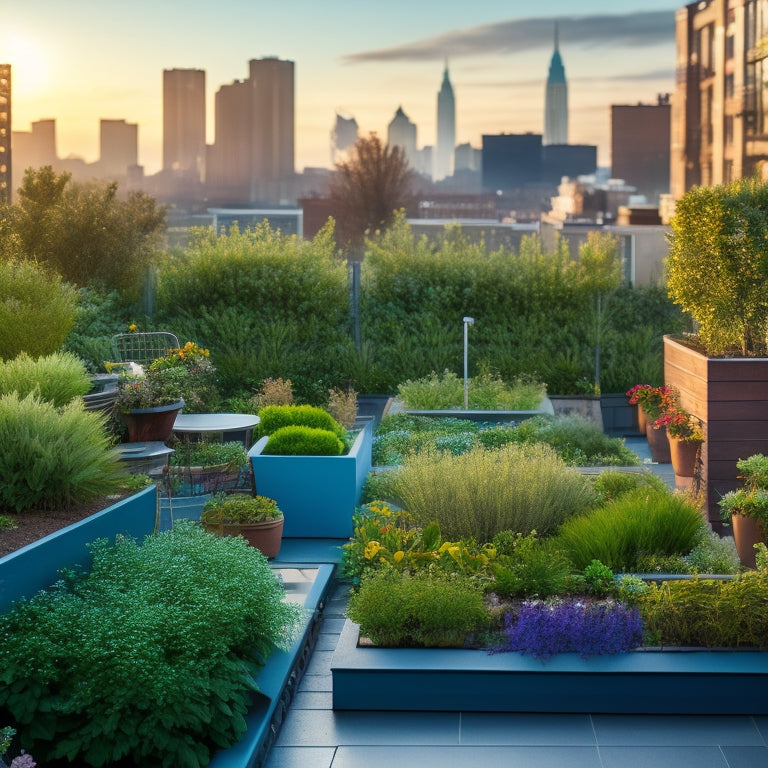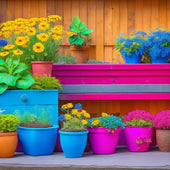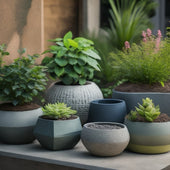
7 Best Rooftop Garden Irrigation Troubleshooting Tips
Share
You know that a well-functioning irrigation system is essential to the health and beauty of your rooftop garden, and troubleshooting common issues promptly is key to preventing water waste, structural damage, and plant stress. Identify clogged emitters, kinked tubes, and malfunctioning timers or sensors that hinder performance. Regularly inspect and maintain your system to detect leaks, clean clogged nozzles, and address pump pressure problems. Verify correct timer programming, clean sensors, and inspect pipes for clogs or damage. By following these tips, you'll be well on your way to a healthy, thriving rooftop garden - and there's even more to explore to guarantee its success.
Key Takeaways
• Regularly inspect and clean pipes to maintain peak water flow and prevent clogs, corrosion, or damage.
• Check and clean clogged nozzles and filters to restore water pressure and coverage.
• Verify correct timer programming and sensor calibration to ensure accurate watering schedules and soil moisture levels.
• Inspect hoses for kinks or blockages, and prime the pump properly to maintain optimal water pressure.
• Winterize your irrigation system by insulating exposed pipes, draining the system, and shutting off the main water supply before winter.
Identifying Common Irrigation Issues
When inspecting your rooftop garden's irrigation system, you'll likely encounter one of several common issues that can impede its performance, including clogged emitters, kinked or damaged tubes, and malfunctioning timers or sensors. These problems can lead to inefficient watering, which can negatively impact soil moisture levels and, ultimately, plant health.
To identify these issues, start by inspecting the emitters, which are prone to clogging from debris and mineral buildup. Check for kinked or damaged tubes, which can restrict water flow and cause uneven distribution.
Next, examine the timers and sensors, making sure they're functioning correctly and providing accurate soil moisture readings.
It's crucial to address these issues promptly, as they can lead to water waste, reduced plant health, and increased maintenance costs. By regularly inspecting and maintaining your irrigation system, you'll guarantee your rooftop garden receives the right amount of water, promoting healthy plant growth and conserving this valuable resource.
Leaks and Water Damage Detection
Detecting leaks and water damage in your rooftop garden's irrigation system is vital, as even slight seepage can cause significant harm to the roofing structure, walls, and ceilings, as well as lead to mold growth and other safety hazards.
You must remain vigilant and proactive in identifying potential issues before they escalate. To do this, you'll need to implement effective moisture monitoring strategies, such as regularly inspecting your irrigation system for signs of water damage, checking for unusual water usage patterns, and using sensors to detect moisture levels.
When it comes to leak detection, prevention strategies are key. You should inspect your irrigation system regularly, looking for signs of wear and tear on components, and replace them as needed. Additionally, make sure that all connections are secure and that there are no blockages in the system.
Clogged Nozzle and Filter Fix
As you examine your rooftop garden's irrigation system, you'll likely encounter clogged nozzles and filters, which can greatly reduce water pressure and coverage, leading to parched plants and inefficient watering.
This common issue can be addressed with regular nozzle maintenance and filter replacement. Start by removing and cleaning the nozzles, checking for mineral buildup, debris, or corrosion. Use a soft-bristled brush or toothbrush to gently scrub away any blockages.
For filters, inspect and replace them as needed, making sure they're compatible with your system. A clean filter ensures peak water flow and irrigation efficiency. Remember to check your system's manual for specific guidelines on nozzle and filter maintenance.
Solving Pump Pressure Problems
Solving Pump Pressure Issues
Inspect your pump's pressure gauge to determine if it's generating the needed pressure to power your rooftop garden's irrigation system, as low pressure can result in insufficient water distribution and plant stress. If the pressure is low, you'll need to troubleshoot the problem.
Check the pump's suction side for any blockages or kinks in the hose, which can restrict water flow and reduce pressure. Verify that the pump is properly primed and that the check valve is functioning correctly.
Regular pump maintenance is vital to prevent pressure issues. Examine the pump's impeller and volute for any indications of wear or corrosion, and replace them if necessary. You may also need to adjust the pressure adjustment screw to enhance the pump's output pressure.
Be careful not to over-pressurize the system, as this can result in pipe damage or nozzle blow-off. By identifying and addressing pump pressure issues, you'll guarantee your rooftop garden receives the appropriate amount of water, promoting healthy plant growth and minimizing water waste.
Troubleshooting Timer and Sensor
You'll need to verify that your timer and sensor are functioning correctly to guarantee your rooftop garden's irrigation system operates on schedule and responds to environmental conditions.
First, check your timer's programming to make sure it's set to water your plants at the right frequency and duration. If you've made recent changes, double-check that they've been saved correctly.
Next, inspect your sensor to confirm it's clean and free of debris, which can affect its accuracy. Perform a sensor calibration to verify it's providing accurate readings. If your sensor is battery-powered, check the battery levels and replace them if necessary.
If your timer and sensor are functioning correctly, but your irrigation system is still not operating as expected, review your system's settings to confirm they're aligned with your rooftop garden's specific needs. Check the sensor's settings to verify it's triggering the irrigation system at the correct moisture levels.
Inspecting and Cleaning Pipes
Turn off the main water supply and drain the system to inspect your rooftop garden's irrigation pipes for signs of clogging, corrosion, or damage. This step is essential in maintaining peak water flow and preventing costly repairs.
As you inspect the pipes, look for mineral buildup, rust, or blockages that could be restricting water flow. Check for leaks, cracks, or loose connections that may be causing water to escape. Perform a water flow analysis to identify any areas where water pressure is low or uneven.
Next, clean the pipes using a pipe cleaning brush or a plumber's snake to remove any debris or obstructions. Make sure to flush the system thoroughly to remove any remaining sediment.
Regular pipe maintenance is vital to guarantee your irrigation system operates efficiently and effectively. By inspecting and cleaning your pipes regularly, you'll be able to identify and address any issues before they become significant problems. This proactive approach will give you peace of mind and save you time and money in the long run, allowing you to enjoy your rooftop garden with freedom and confidence.
Winterizing Your Irrigation System
When the irrigation system is in good working order after inspecting and cleaning the pipes, it's time to prepare it for the harsh winter months by winterizing the system to prevent freezing temperatures from causing damage.
You'll want to insulate exposed pipes to prevent freezing, which can lead to costly repairs or even system failure. Use foam pipe insulation or wrap pipes with heat tape or thermostatically controlled heat cables to keep them warm.
Next, drain the system to protect its components from freezing temperatures. Shut off the main water supply and open the drain valves to allow water to drain out. You may need to use compressed air to blow out any remaining water in the pipes. Don't forget to drain the irrigation controller and any other components that hold water.
Frequently Asked Questions
Can I Use a Drip Irrigation System for Rooftop Gardens?
You can definitely use a drip irrigation system for your rooftop garden, as it offers benefits like water efficiency and reduced evaporation, which is essential for overcoming rooftop garden challenges like wind, sun, and limited soil depth.
How Often Should I Inspect My Irrigation System?
You should inspect your irrigation system regularly, ideally every 2-3 weeks, to catch common issues like clogs, leaks, and misaligned emitters, and incorporate it into your maintenance schedule to guarantee efficient watering and troubleshooting techniques.
Are Smart Irrigation Controllers Worth the Investment?
You'll find smart irrigation controllers worth the investment, as they boost energy efficiency and water savings while offering remote access and customization options, giving you total control and freedom to optimize your rooftop garden's hydration.
Can I Use Rainwater for My Rooftop Garden Irrigation?
You're wise to ponder rainwater for your rooftop garden irrigation, as it's a brilliant way to conserve water and adopt sustainable practices, supporting your freedom to garden with minimal environmental impact.
Do I Need to Hire a Professional for Irrigation System Installation?
You can opt for DIY installation, but consider hiring a pro to guarantee a leak-free, efficient system; they'll handle complex tasks, freeing you to focus on your rooftop garden, and providing peace of mind with professional maintenance.
Related Posts
-

10 Essential Steps to Upcycle Concrete Planters
You've decided to breathe new life into those old concrete planters lying around, and you're ready to transform them ...
-

10 Essential Steps to Upcycle Concrete Planters
You've decided to breathe new life into those old concrete planters lying around, and you're ready to transform them ...
-

10 Essential Steps to Upcycle Concrete Planters
You've decided to breathe new life into those old concrete planters lying around, and you're ready to transform them ...
-

10 Essential Steps to Upcycle Concrete Planters
You've decided to breathe new life into those old concrete planters lying around, and you're ready to transform them ...
-

10 Essential Steps to Upcycle Concrete Planters
You've decided to breathe new life into those old concrete planters lying around, and you're ready to transform them ...
-

10 Essential Steps to Upcycle Concrete Planters
You've decided to breathe new life into those old concrete planters lying around, and you're ready to transform them ...
-

10 Essential Steps to Upcycle Concrete Planters
You've decided to breathe new life into those old concrete planters lying around, and you're ready to transform them ...
-

10 Essential Steps to Upcycle Concrete Planters
You've decided to breathe new life into those old concrete planters lying around, and you're ready to transform them ...
-

10 Essential Steps to Upcycle Concrete Planters
You've decided to breathe new life into those old concrete planters lying around, and you're ready to transform them ...
-

10 Essential Steps to Upcycle Concrete Planters
You've decided to breathe new life into those old concrete planters lying around, and you're ready to transform them ...
-

10 Essential Steps to Upcycle Concrete Planters
You've decided to breathe new life into those old concrete planters lying around, and you're ready to transform them ...
-

10 Essential Steps to Upcycle Concrete Planters
You've decided to breathe new life into those old concrete planters lying around, and you're ready to transform them ...
-

10 Essential Steps to Upcycle Concrete Planters
You've decided to breathe new life into those old concrete planters lying around, and you're ready to transform them ...
-

10 Essential Steps to Upcycle Concrete Planters
You've decided to breathe new life into those old concrete planters lying around, and you're ready to transform them ...
-

10 Essential Steps to Upcycle Concrete Planters
You've decided to breathe new life into those old concrete planters lying around, and you're ready to transform them ...
-

10 Essential Steps to Upcycle Concrete Planters
You've decided to breathe new life into those old concrete planters lying around, and you're ready to transform them ...
-

10 Essential Steps to Upcycle Concrete Planters
You've decided to breathe new life into those old concrete planters lying around, and you're ready to transform them ...
-

10 Essential Steps to Upcycle Concrete Planters
You've decided to breathe new life into those old concrete planters lying around, and you're ready to transform them ...
-

10 Essential Steps to Upcycle Concrete Planters
You've decided to breathe new life into those old concrete planters lying around, and you're ready to transform them ...
-

10 Essential Steps to Upcycle Concrete Planters
You've decided to breathe new life into those old concrete planters lying around, and you're ready to transform them ...
-

10 Essential Steps to Upcycle Concrete Planters
You've decided to breathe new life into those old concrete planters lying around, and you're ready to transform them ...
-

10 Essential Steps to Upcycle Concrete Planters
You've decided to breathe new life into those old concrete planters lying around, and you're ready to transform them ...
-

10 Essential Steps to Upcycle Concrete Planters
You've decided to breathe new life into those old concrete planters lying around, and you're ready to transform them ...
-

10 Essential Steps to Upcycle Concrete Planters
You've decided to breathe new life into those old concrete planters lying around, and you're ready to transform them ...
-

10 Essential Steps to Upcycle Concrete Planters
You've decided to breathe new life into those old concrete planters lying around, and you're ready to transform them ...
-

10 Essential Steps to Upcycle Concrete Planters
You've decided to breathe new life into those old concrete planters lying around, and you're ready to transform them ...
-

10 Essential Steps to Upcycle Concrete Planters
You've decided to breathe new life into those old concrete planters lying around, and you're ready to transform them ...
-

10 Essential Steps to Upcycle Concrete Planters
You've decided to breathe new life into those old concrete planters lying around, and you're ready to transform them ...
-

10 Essential Steps to Upcycle Concrete Planters
You've decided to breathe new life into those old concrete planters lying around, and you're ready to transform them ...
-

5 Best DIY Planter Ideas to Upcycle Concrete
You're about to breathe new life into discarded concrete blocks by transforming them into functional and visually app...
-

5 Best DIY Planter Ideas to Upcycle Concrete
You're about to breathe new life into discarded concrete blocks by transforming them into functional and visually app...
-

5 Best DIY Planter Ideas to Upcycle Concrete
You're about to breathe new life into discarded concrete blocks by transforming them into functional and visually app...
-

5 Best DIY Planter Ideas to Upcycle Concrete
You're about to breathe new life into discarded concrete blocks by transforming them into functional and visually app...
-

5 Best DIY Planter Ideas to Upcycle Concrete
You're about to breathe new life into discarded concrete blocks by transforming them into functional and visually app...
-

5 Best DIY Planter Ideas to Upcycle Concrete
You're about to breathe new life into discarded concrete blocks by transforming them into functional and visually app...
-

5 Best DIY Planter Ideas to Upcycle Concrete
You're about to breathe new life into discarded concrete blocks by transforming them into functional and visually app...
-

5 Best DIY Planter Ideas to Upcycle Concrete
You're about to breathe new life into discarded concrete blocks by transforming them into functional and visually app...
-

5 Best DIY Planter Ideas to Upcycle Concrete
You're about to breathe new life into discarded concrete blocks by transforming them into functional and visually app...
-

5 Best DIY Planter Ideas to Upcycle Concrete
You're about to breathe new life into discarded concrete blocks by transforming them into functional and visually app...
-

5 Best DIY Planter Ideas to Upcycle Concrete
You're about to breathe new life into discarded concrete blocks by transforming them into functional and visually app...
-

5 Best DIY Planter Ideas to Upcycle Concrete
You're about to breathe new life into discarded concrete blocks by transforming them into functional and visually app...
-

5 Best DIY Planter Ideas to Upcycle Concrete
You're about to breathe new life into discarded concrete blocks by transforming them into functional and visually app...
-

5 Best DIY Planter Ideas to Upcycle Concrete
You're about to breathe new life into discarded concrete blocks by transforming them into functional and visually app...
-

5 Best DIY Planter Ideas to Upcycle Concrete
You're about to breathe new life into discarded concrete blocks by transforming them into functional and visually app...
-

5 Best DIY Planter Ideas to Upcycle Concrete
You're about to breathe new life into discarded concrete blocks by transforming them into functional and visually app...
-

5 Best DIY Planter Ideas to Upcycle Concrete
You're about to breathe new life into discarded concrete blocks by transforming them into functional and visually app...
-

5 Best DIY Planter Ideas to Upcycle Concrete
You're about to breathe new life into discarded concrete blocks by transforming them into functional and visually app...
-

5 Tips for Shaded Area Gardening Success
To turn your shaded areas into thriving gardens, start by selecting shade-tolerant crops like leafy greens and herbs,...
-

5 Tips for Shaded Area Gardening Success
To turn your shaded areas into thriving gardens, start by selecting shade-tolerant crops like leafy greens and herbs,...
-

5 Tips for Shaded Area Gardening Success
To turn your shaded areas into thriving gardens, start by selecting shade-tolerant crops like leafy greens and herbs,...
-

5 Tips for Shaded Area Gardening Success
To turn your shaded areas into thriving gardens, start by selecting shade-tolerant crops like leafy greens and herbs,...
-

5 Tips for Shaded Area Gardening Success
To turn your shaded areas into thriving gardens, start by selecting shade-tolerant crops like leafy greens and herbs,...
-

5 Tips for Shaded Area Gardening Success
To turn your shaded areas into thriving gardens, start by selecting shade-tolerant crops like leafy greens and herbs,...
-

5 Tips for Shaded Area Gardening Success
To turn your shaded areas into thriving gardens, start by selecting shade-tolerant crops like leafy greens and herbs,...
-

5 Tips for Shaded Area Gardening Success
To turn your shaded areas into thriving gardens, start by selecting shade-tolerant crops like leafy greens and herbs,...
-

5 Tips for Shaded Area Gardening Success
To turn your shaded areas into thriving gardens, start by selecting shade-tolerant crops like leafy greens and herbs,...
-

5 Tips for Shaded Area Gardening Success
To turn your shaded areas into thriving gardens, start by selecting shade-tolerant crops like leafy greens and herbs,...
-

5 Tips for Shaded Area Gardening Success
To turn your shaded areas into thriving gardens, start by selecting shade-tolerant crops like leafy greens and herbs,...
-

5 Tips for Shaded Area Gardening Success
To turn your shaded areas into thriving gardens, start by selecting shade-tolerant crops like leafy greens and herbs,...
-

5 Tips for Shaded Area Gardening Success
To turn your shaded areas into thriving gardens, start by selecting shade-tolerant crops like leafy greens and herbs,...
-

5 Tips for Shaded Area Gardening Success
To turn your shaded areas into thriving gardens, start by selecting shade-tolerant crops like leafy greens and herbs,...
-

5 Tips for Shaded Area Gardening Success
To turn your shaded areas into thriving gardens, start by selecting shade-tolerant crops like leafy greens and herbs,...
-

5 Tips for Shaded Area Gardening Success
To turn your shaded areas into thriving gardens, start by selecting shade-tolerant crops like leafy greens and herbs,...
-

5 Tips for Shaded Area Gardening Success
To turn your shaded areas into thriving gardens, start by selecting shade-tolerant crops like leafy greens and herbs,...
-

5 Tips for Shaded Area Gardening Success
To turn your shaded areas into thriving gardens, start by selecting shade-tolerant crops like leafy greens and herbs,...
-

5 Tips for Shaded Area Gardening Success
To turn your shaded areas into thriving gardens, start by selecting shade-tolerant crops like leafy greens and herbs,...
-

5 Tips for Shaded Area Gardening Success
To turn your shaded areas into thriving gardens, start by selecting shade-tolerant crops like leafy greens and herbs,...


